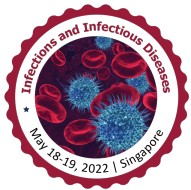Solomon Ejigu
Mizan-Tepi University, Ethiopia
Title: Effect of Malaria and HIV/AIDS co-infection on Red Blood Cell Indices and Its relation with the CD4 level of Patients on HAART in Bench Sheko Zone, Southwest Ethiopia
Biography
Biography: Solomon Ejigu
Abstract
Background
Malaria and HIV/AIDS are the two most common infections in sub Saharan Africa (SSA) and worldwide. HIV infected individuals in malaria endemic areas experience severe malaria episodes. The immunological basis of this clinical observation is unclear and the hematologic abnormalities such as anemia in malaria and HIV co infected patients were inconsistent from studies in the past. Ethiopia’s three-fourth of the landmass is malarious and HIV prevalence is high that significantly affect RBC indices and other hematologic profiles.
Objective: This study aimed to compare RBC indices and anemia in HIV patients’ co-infected with malaria and those HIV patients without malaria and correlates these with CD4 level.
Methods: A comparative cross-sectional study was employed on 103 malaria-HIV/AIDS co infected (MHC) and 103 HIV patients without malaria on HAART of the same ART centers in Bench Sheko Zone. Data was collected by structured questionnaire and blood samples were collected from both groups for malaria test and RBC indices measurement. Data was entered and checked in Epi-data and exported to IBM SPSS version 21 software packages for analysis.
Results There were significant differences in Mean±SD of RBC indices between the two groups (PË‚0.001). RBC, Hgb, HCT and MCV were lower in MHC patients. In total study participants, significant positive correlation was observed between CD4 count with MCV, CD4 count with MCH and CD4 count with anemia. In the group of malaria-HIV co-infected, CD4 count with RBC and CD4 count with Hgb and in HIV without malaria CD4 count with MCV, CD4 count with MCH and CD4 count with MCHC were positively correlated. Overall anemia prevalence was 45.1%. Anemia prevalence in MHC (Malaria-HIV co-infected) was 63.4 %. Anemia prevalence distribution among sex showed that 61.3 % in female sex and anemia prevalence distribution among CD4 group showed 55.9% in patients with CD4 count of ≤500 cells/μl. Anemia in MHC patients was higher in those with CD4 count of ≤500 cells/μl (59.3 %) while in OH (Only HIV infected) anemia prevalence was similar in those with CD4 count of ≤500 and ≥500 cells/μl (50 %). There is significant difference in anemia in MHC and OH infected with different CD4 group (PË‚0.01).
Conclusion: There was a difference in RBC indices in both groups; RBC, Hgb, HCT and MCV were lower in MHC patients. There was positive correlation between CD4 counts with some RBC indices in combined both groups. However, there was positive correlation between CD4 counts with RBC and Hgb in malaria-HIV co-infected. The combined prevalence of anemia was higher and anemia in MHC was greater than OH infected patients.
Key words: CD4+ T cells, HAART, Malaria-HIV/AIDS co-infection, RBC indices, Anemia, Bench Sheko Zone.

